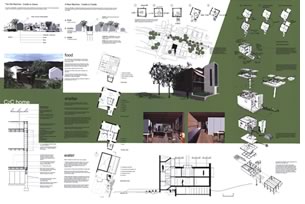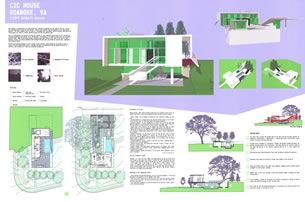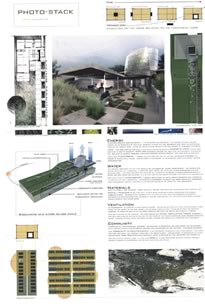

03/2005
Cradle to cradle. The term is actually derived from the term “cradle-to-grave products,” for items that end up in a final landfill “grave” at the end of their useful life, like a milk carton. Cradle-to-cradle products, on the other hand, are perpetually reborn, that is, recycled. They also don’t damage ecosystems. The concept of “Cradle to Cradle Home Design” was developed by design pioneers William McDonough, FAIA, and Michael Braungart as a strategy for developing “ecologically intelligent products that generate economic, social, and environmental benefits at every phase of their use.”
McDonough and Braungart explain the concept in their book, Cradle to Cradle: Remaking the Way We Make Things (North Point Press, 2002). The key is to think in terms of a big loop. Depending on their “nutrients,” two kinds of materials can potentially flow in a continuous loop: biological and mineral (which includes synthetic). Recycling allows materials to safely “loop” through the environment and nourish living systems, or be remanufactured into new materials. A cradle-to-cradle home is built from these materials.
Building C2C homes
Architects, students, and university teams over the past eight months
accepted the invitation to design a cradle-to-cradle house for one
of four sites in Roanoke, Va. The C2C Home Design Competition received
more than 625 registrations from over 60 universities and more than
40 countries. This was the first C2C competition.
The aim was to design affordable, environmentally friendly homes, with the ultimate intent of building them in a modern barn-raising fashion. The sites chosen for construction are vacant lots in Roanoke, that are in established neighborhoods, so the green homes must blend in but also look progressive. The winners were chosen in January and received $5,000. More than 200 of the best design submissions were on display at the Art Museum of Western Virginia in Roanoke last month, and construction begins in May.
 Jurors
included McDonough; Alexander Garvin, director of planning for NYC2012
and New York City planning commissioner; Daniel Libeskind, AIA, internationally
renowned architect of the Freedom Tower at Ground Zero as well as the
award-winning Berlin Holocaust Museum; Randall Stout, FAIA, international “green” architect
and former associate with Frank Gehry, FAIA; and Sarah Susanka, FAIA,
author and a leader behind the “not so big” approach to residential
architecture.
Jurors
included McDonough; Alexander Garvin, director of planning for NYC2012
and New York City planning commissioner; Daniel Libeskind, AIA, internationally
renowned architect of the Freedom Tower at Ground Zero as well as the
award-winning Berlin Holocaust Museum; Randall Stout, FAIA, international “green” architect
and former associate with Frank Gehry, FAIA; and Sarah Susanka, FAIA,
author and a leader behind the “not so big” approach to residential
architecture.
Partnerships for the construction in Roanoke include the AIA, Environmental Design + Construction magazine, American Society of Interior Designers, and GreenBlue.
A green vision
The C2C Home Design Competition was the brainchild of Gregg Lewis, AIA,
SmithLewis Architecture, after meeting with McDonough in 2003.
“I invited Bill McDonough to Roanoke and there was talk of doing a housing competition. My wife, who is a business partner, and I decided it made sense to use C2C as a reference for the competition, so we called Bill and he was generous in allowing us to run with it.”
 Local
interest in Roanoke has been impressive, with many residents and businesses
volunteering time and donating building lots.
Local
interest in Roanoke has been impressive, with many residents and businesses
volunteering time and donating building lots.
“People here are just really thrilled,” enthuses Lewis. “The local art museum of Western Virginia hosted the jury activities and put up 220 of the designs. The museum let us leave them up for public exhibition and they had more than 5,000 people come through the exhibition, which is apparently the best-attended exhibition they ever had. It’s been really quite astonishing.”
The competitors were assigned to design for a specific lot, one of four, in an existing neighborhood. “We felt that was vital because the more explicit the design problem was, the higher degree of work we were going to get.” says Lewis. “That proved to be the case as we saw the designs coming in. The strategy is also to serve as an urban revitalization project.”
Lewis believes that the C2C protocol is the logical conclusion to all sustainability activities. “For us it’s really the end-game. We need to get rid of the toxic material that we know to be carcinogenic. C2C is trying to reverse that kind of thinking. Can our buildings produce more energy than they use, recycle their own water onsite, and have materials that are recyclable?
“So as we pass the baton to our children and grandchildren, we can say we wanted to leave the planet in better shape than when we took it over from our parents. Whether its water quality, air quality, or abundance of natural resources.”
 The cradle of a new civilization?
The cradle of a new civilization?
Lewis points out that we cannot underestimate McDonough’s role
in partnering with industry. For example, Ford has developed an
SUV called the Model U that is designed using the C2C protocol, while
BASF also uses C2C to design a rigid insulation product that is 100 percent
recyclable and doesn’t toxify. Shaw Industries, the largest carpet
manufacturer in the world, also is involved in designing a product using
the C2C concept.
“I think we can look at this as a utopian vision,” states Lewis. “It’s something being increasingly realized everyday by different industries. It’s going to continue to move in this direction.”
Lewis sees the C2C competition as a way to increase awareness for healthy homes. Based on the current interest and excitement in Roanoke, he is very encouraged. “There are a lot of folks out there who have found ways to be involved in this, and it’s very exciting to see that interest level continue to ramp up. My thinking is that once we have several of these houses under construction and near completion, the interest level will continue to increase. Who knows, we may get a real shift in the way people think about the future of building.”
Copyright 2005 The American Institute of Architects.
All rights reserved. Home Page ![]()
![]()

